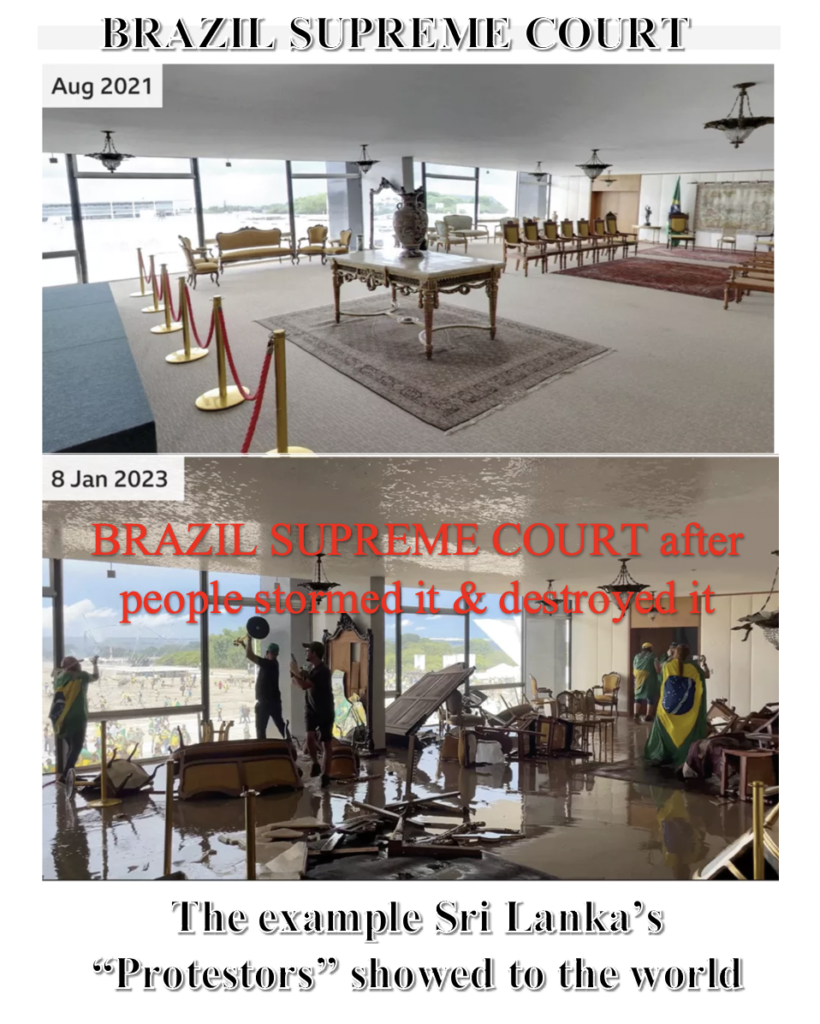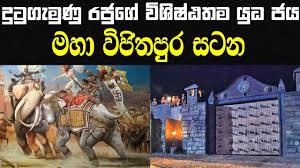How did protestors succeed in ousting a President in Sri Lanka but failed in Brazil

In July 2022, protestors in Sri Lanka were made to believe, their protest forced the exit of the elected President. In January 2023 protestors in Brazil failed to overthrow the elected government. There are similarities and differences, but it should certainly tell people that protests elevated to riots & violence are not democracy or human rights.
What were the common slogans used in both countries by protestors? The slogans had an uncanny resemblance to those used in the protests across the Middle East too.
- “we want to overthrow the thieves”
- “we are not here for …….. we are here for ……..”
- “our future is being stolen”
- “a totally peaceful protest” – though rioters invaded, occupied, damaged & stole public property
The Brazil protest had a leader – Jair Bolsonaro, the former President of Brazil with multiple criminal investigations against him refusing to accept the election results, Sri Lanka’s protestors had several leaders. Former President Bolsonaro wanted to return to power via the protestors, in Sri Lanka, former Prime Minister rejected at elections, actually became the President as a result of the protests.
Brazil protestors turned into rioters & raided Brazil’s Congress – Sri Lanka’s protestors proposed to do the same but failed.

Brazil’s rioters raided the Supreme Court, Presidential Offices – Sri Lanka’s protestors raided the President’s Office, Presidents Residence, Presidents Secretariat, PM’s Office, PM’s Residence but not the Supreme Court.
Brazil’s & Sri Lanka’s protestors attempted to woo the Armed Forces & Police to join them to topple the government.
Both incidents followed what took place in US Capitol Hill on 6 January 2021.
The events were like a manual being followed.
The difference in Brazil’s & Sri Lanka’s scenarios was the prompt action taken by the Brazilian President & Judicial authorities – orders were issued to arrest the rioters, to clear the encampment sites, funding parties & organizers were immediately investigated & arrested. All areas that were lacking in Sri Lanka.
A question that many continue to ask is why in both cases the situation was allowed to aggravate when the telltale signs were visible about what the proposed unarmed “peaceful protestors” were about to do. Their social media accounts made public sentiments of their plans which authorities should have picked up & prepared contingencies for. The placards they carried directly implicated who they were targeting. The media unknowingly provided clues as well. Why were the warnings of intelligence officials not heeded too?
Why were the armed forces & police “sympathetic” to the rioters in both cases? The resistance by law enforcement was minimal & this has to be questioned. Were their non-action as a result of top-down orders or did they simply decide not to carry out orders? If orders were given not to take action – what has been the punitive action taken against those giving orders. If officers chose not to act – what has been the punishment for not carrying out their duties? Brazil suspended the governor responsible for protecting the buildings & arrested 2 top security officials working for him – what arrests did Sri Lanka make?
The answers all lie in following the money trail. No campaign protest in either country could have been carried out without funding, technical support, digital campaigns etc. In both Brazil & Sri Lanka, the role of business elites became exposed. Many of them unabashedly even attended the riots providing high-profile presence and bringing artists, sports personalities, as well as the usual culprits to give a boost to the ordinary people who felt inspired and thrilled to be considered on an ‘equal’ platform, even though it was in reality a sham show. These ordinary protestors can see how welcome they are now, were they to walk into the offices/residences of the same business elites!
In both Brazil & Sri Lanka – the outcome of the riots was the disappointment of large portions of society in the democratic framework. The positive side to this is the people’s call to change the electoral system and prune down the government. Many of the politicians that covertly aligned with the protestors are unlikely to want such a change as it would impact their entry to Parliament.
The role of social media in Brazil & Sri Lanka
Who trained the ‘online influencers’ in both nations, why were the slogans used in both nations so similar? There were many more uncanny resemblances in the calls made to people via social media, spurring them to hate, take revenge and feel anger. It was clear that social media platforms were being intentionally used to spur people’s emotions and draw them to the roads. The media, minute by minute broadcasts were meant to make people join in & not feel they were left out, the idea was to spread the notion that everyone had to take to the road to be part of a historic ‘people’s protest’ – though the actors and actresses spurring them, were paid to beckon people, went unnoticed or questioned. Everyone was made to feel that they had to be present to mark their presence. The applause given by the international community also provided that nod of approval.
Brazil’s protestors left the Supreme Court in shambles. The rioters even went off with Brazil’s coat of arms. Sri Lanka’s rioters also stole public property including the official flag of the President.
The Brazilian President took prompt action even arresting top Police officials for inaction & the former Justice Minister who was aligned to the former President leading the protestors. The head of Brazils military police was also arrested.
The Brazilian authorities soon discovered that the online payment system PIX was used to receive funds & those arrested will be charged with terrorism & attempting a coup. President Lula made his stand clear – those who protested will be given the right to defend themselves but if they have been found guilty of disobeying the laws of the land they will be punished.
Another interesting aspect was the manner food, fuel, fertilizer came to be central focus of protestors in Sri Lanka & Brazil. The reason for the anger was primarily these 3 issues in Sri Lanka while in Brazil, the protestors began hindering supply chain of these 3 items triggering a clash. We have to also wonder whether the corporates and other elites who took centre stage in Sri Lanka’s protests, and were operating the supply chains intentionally disrupted supplies to anger the people and use that to set the stage for the protest and ouster of an elected president. Majority of the protestors were clueless of clauses in the constitution on who takes over after a president exits. Many were not expecting the rejected UNP leader to emerge the President of Sri Lanka and that came about with the forcing of the resignation of the former PM which later elevated to taking over as interim President with the exit of the former President.
The protestors in Sri Lanka have found out too late that their angst against fuel, food, gas, electricity that demanded the resignation of a President will not stop fuel increases, food shortages, tax increases or even electricity cuts and how many times are they to take to the streets and remove the ruler without pinpointing where the problem lies – it is excessive consumerism that has to be addressed together with the increasing inequalities that prevail. Selling the coutnry’s silver is not the solution to continue consumerisms which is a selfish solution by those who only want to enjoy a lavish lifestyle at the cost of the majority of people who are poor & unable to make ends meet.
Shenali D Waduge





